Big rocks’ balancing acts
Scientists study how balanced boulders resist falling over — and what that may say about earthquakes.
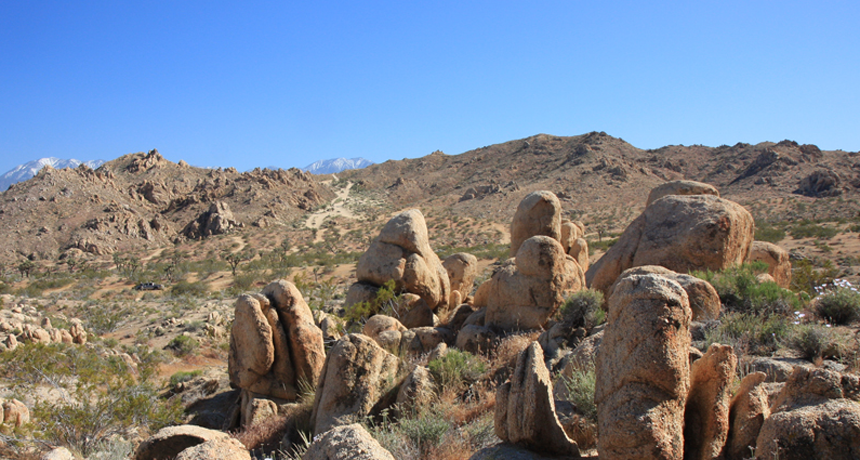
In some parts of southern California, hundreds of balanced rocks can be found within a few square kilometers.
Douglas Fox
By Douglas Fox
Richard Brune was pretty dizzy the first time he shot photos while leaning out of a flying airplane.
The plane’s door had been removed so Brune could ride with one leg outside. As the tiny propeller plane zigzagged over the desert, Brune leaned out over empty air. The 80 mile-per-hour headwind pummeled his face. He looked through his camera and snapped pictures of the rocky desert hundreds of feet below.
He got woozy after a few seconds, unsure which way was up. He learned to avoid that feeling by keeping his eyes on the shifting, slanting horizon whenever he could. And just in case he tumbled out of the plane, he wore a parachute. “It’s not that bad,” says Brune, who has done plenty of skydiving. “From 1,000 feet you’ve probably got at least nine or 10 seconds [of falling] before you really have to pull the rip cord.”
Brune wasn’t flying over the desert in southern California to be a daredevil. He was taking pictures of balanced rocks. Big, balanced rocks. Really awkward ones. The kind of rock that looks like it would tip over, roll down a hill and flatten a car if someone were silly enough to lean against it.
Odd hobby
Richard and his dad, James Brune, have a passion for balanced rocks. James is a geologist, someone who studies the history and movement of the Earth as recorded in rocks, at the University of Nevada in Reno. He has spent 20 years looking for balanced rocks across the deserts of Nevada and California.
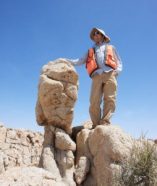
“We’ve found literally thousands of these rocks,” says James. Some of them stand up to 5 meters tall and weigh 15,000 kilograms — real car crushers!
It sounds like an odd hobby, but James, the geologist, is serious about these rocks. He has also studied earthquakes for many years, and he believes that balanced rocks can tell us something important about earthquakes.
Standing strong
An earthquake’s tremors can topple balanced rocks. So if you look at these rocks across California, you should find clues about where sizable earthquakes have happened.
In places that haven’t experienced large earthquakes, you should find really delicate rocks — ones you could tip over with a finger. But in places that have seen more serious quakes, the only rocks left standing in the balance should be those that are far harder to tip over.
Geologists find these rocks so interesting because they could give clues about the severity of earthquakes over thousands of years. In parts of California, records collected by scientists go back only about 150 years. Historical data on tremor intensities are important when determining how strong a bridge or dam needs to be to survive earthquakes.
How old is old?
All of this depends, of course, on finding out how long the balanced rocks have been standing.
It’s a basic question, really: How quickly does the land change? Maybe you’ve wondered it yourself. Have you ever walked down a path, kicked a rock and wondered how long that rock had stood there before you knocked it down the hill? Maybe it was there for one year. Maybe 100 years. Perhaps even 10,000 years.
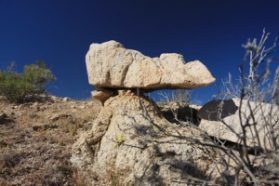
Believe it or not, scientists have clever ways to figure this stuff out.
Earlier this year, Richard Brune went to the Mojave Desert in southern California to find out how long some balanced rocks have been standing.
The desert slopes gently away from a mountain of globby shaped granite rocks. Gravel and lots of prickly plants cover the ground. Richard has parked his Jeep at the end of a bumpy dirt road. He now walks on the sandy bottom of a winding gully with Dylan Rood, a geologist from Lawrence Livermore National Laboratory in California.
Speckled granite rocks stacked like giant brown marshmallows tower above the gully on both sides. Now and then, Richard and Rood spot a rock balanced on top of the stack, like a milk jug standing upside down.
“Be careful,” says Richard, as Rood approaches one rock. “That one could go off easily. It wouldn’t take much.”
Several minutes later, Rood climbs to another rock, this one the size of a TV, sitting on top of the marshmallows. “Woohoo!” he hollers to Richard. “Just with a thumb I can move it.”
Carved by water
People often assume that rocks become balanced after falling on top of each other. But that wasn’t the case for these marshmallow stacks — there’s nowhere the balanced rocks could have rolled from above.
Instead, scientists think these balanced rocks were probably carved by water. As rivers cut gullies into the granite bedrock beneath the desert floor, water chews away the weaker types of rock, leaving only the stronger behind.
Imagine a house built of strong bricks and held together by weak cement — bedrock often has these strong and weak parts, although they aren’t always visible. If the house is continuously exposed to running water, the cement will gradually wear away. But the bricks will remain. And some of the bricks will be left stacked or balanced on top of each other — like the granite marshmallows in the gully.
Rood thinks that most of these rocks were carved out during the last Ice Age. “There was a lot more water,” he says. “There were big lakes all over the Mojave Desert.” If that’s true, it would mean these rocks have been standing like bowling pins in the desert for 15,000 to 20,000 years — four or five times longer than the pyramids of Egypt!
Sunburned rock
Rood and Richard plan to test this age estimate. Late one afternoon, a couple of days after their walk through the marshmallow gully, they find a refrigerator-sized boulder that looks ready to roll downhill.
Unlike a lot of the other balanced rocks they’ve seen, this one is on the side of a small mountain, in a place where it could have landed after rolling from somewhere higher up. But Richard and Rood have a way of knowing that it didn’t. They can tell, in fact, that it’s sitting within a few centimeters of where it was eroded out of the surrounding bedrock.
Rood points out a vein of brownish quartz crystals, several fingers thick, that runs through the bedrock a few meters behind the rock. That layer runs for 30 meters before disappearing. It is tilted, like the hour hand of a wall clock at 8 o’clock — but otherwise straight as an arrow. That same layer of quartz runs through the boulder. It is perfectly lined up with the layer in the bedrock. It would be a pretty unlikely coincidence if the boulder just rolled down the mountain and landed that way. This rock has to be sitting in its original birthplace.
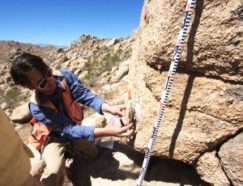
Rood measures this by using an accelerator-mass spectrometer, a monster machine the size of an 18-wheeler. He’ll use this machine to measure tiny amounts — a few quadrillionths of a gram — of a rare radioactive form of the element beryllium.
This rare form, called beryllium-10, is created when cosmic rays from space hit the rock and split apart larger atoms of oxygen and nitrogen. You might say that when this happens, the rock is getting sunburned. As long as the rock is sitting out in the open, the cosmic rays are hitting it and beryllium-10 is forming in the outer 2 or so centimeters of the rock. But while the rock is buried underground — before running water chews it out of the desert floor — it’s shaded from cosmic rays, so no beryllium-10 develops.
Oldest places
By measuring the sunburn — that is, the amount of beryllium-10 in the rock fragments — scientists can tell how long ago the rock emerged from the surrounding bedrock.
Rood has already used this method, called exposure dating, on one balanced rock in the Mojave Desert. He found that it had been freestanding for 18,000 years — about what he expected if the rock was carved out during the last Ice Age.
Scientists have used exposure dating all over the world. Deserts, usually the oldest places, change the slowest because there is little water to alter the landscape. Once a rock is standing, it can stay still for a long time because there is hardly any water to erode it or wash it away. And during the winter, ice doesn’t form inside cracks in the rock and slowly pry it apart.
In places with lots of water, things change quickly. Over the past 150 years, the Missouri River has shifted its winding path by three kilometers in some places, leaving its mark in the landscape.
Antarctica probably has the oldest, most unchanging landscapes on Earth. Ice covers most of the continent, but a few small areas remain ice-free. In one such place, called the Olympus Range, you can sit on boulders that haven’t moved in five or six million years! The rocks survived because Antarctica is a desert: It is so cold that it receives hardly any rain or snow. The continent was once warmer and wetter, but when it became cold and dry, it stayed that way.
Rock tipping
Here in California, Rood and Richard need to know not only how long their precariously balanced rocks have been standing but also how hard they are to knock over.
These are tough questions. The best way to find out how firmly in place a rock is — simply push it over. But toppling a rock that’s been balanced for 18,000 years is sort of like chopping down one of the oldest redwood trees. No one wants to do it.
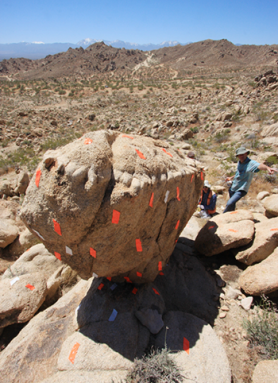
The Brunes convinced the developer to let them do it for him. They fastened a steel cable to each rock and used a gadget to measure exactly how much pulling was needed to bring down the boulder. “It was kind of fun,” admits James. “They were 7 or 8 feet high and weighed many tons.” And each landed with a satisfying thud.
Richard has also found less destructive ways to pull on rocks. Out in the Mojave Desert with Rood, he takes out a camera and begins photographing from all sides the refrigerator-sized boulder they’re studying.
Back at home, he’ll load the photos into a computer that will stitch the pictures into a three-dimensional model of the rock — a virtual rock.
Richard can then run that virtual rock through a computer program that shakes and knocks the rock down many times. By tipping that virtual rock they can ensure that the other one — the real rock — has a fighting chance to stay standing for another 18,000 years.







